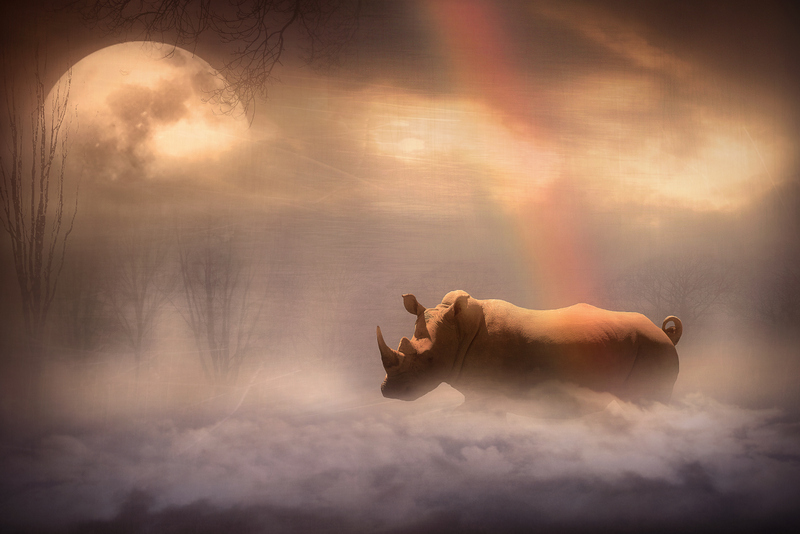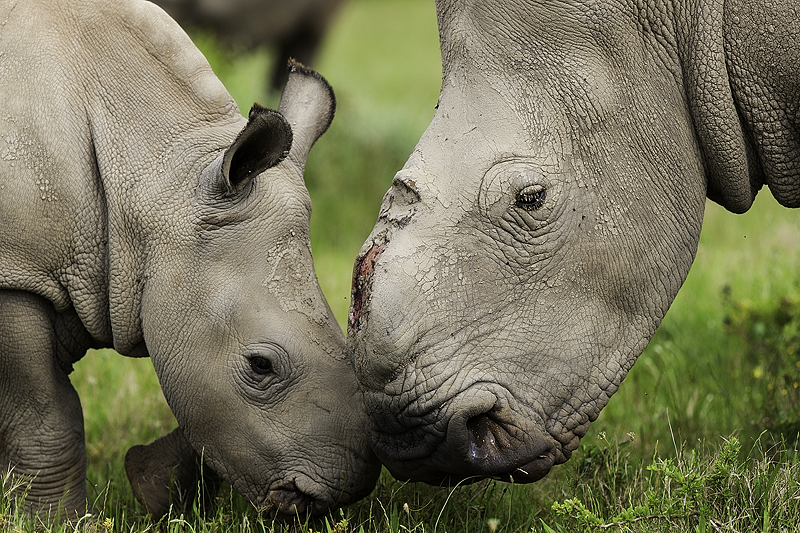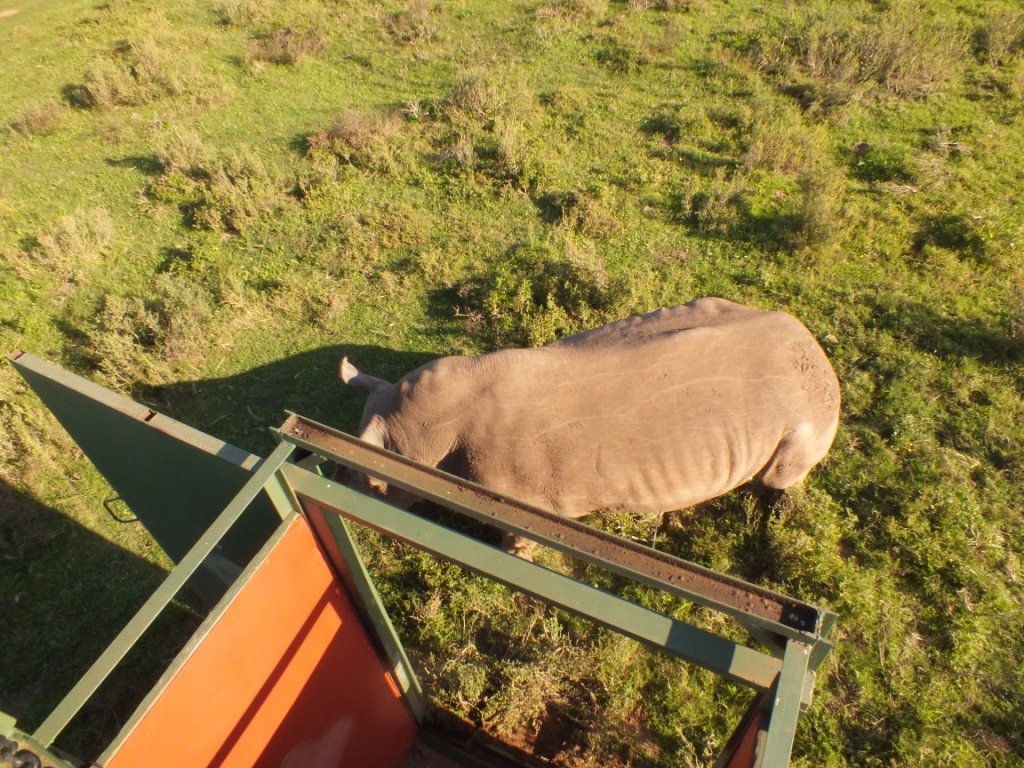Thandi's Story - Part III - Kariega Game Reserve
Part III in a four part blog on the poaching of Thandi and Themba at Kariega Game Reserve, of the people closest to them, and of their path to recovery and struggle in the fight against poaching. Written by local journalist, Lauren Flynn.
View Part I and II here
Courage in the loss of hope
Part III
By Lauren Daisy Flynn
Themba abandoned the most primordial desire to a living creature – the will to live. He could have lifted his head if had wanted to, but he couldn’t muster the energy to stand up and continue in his misery.
His suicide, you could call it, is a common trait in the species. Rhinos have been known to venture off to find a place to lie down and die of their own accord. Thandi and Themba were no different.
The rangers always knew it could happen, so they constantly watched over the two of them for the first few days after the poaching incident. They had to intervene if the rhinos eventually gave in to their injuries. Thandi lay down twice in the first few hours of being given the antidote. The first instance was in weariness and pain, but the second time she rolled onto her side as if she was preparing to die.
Shaun followed her in the game-viewing vehicle keeping Dr Fowlds on standby to rush back and assess whether she was resting or trying to die. Fortunately, Thandi was a fighter. The rangers swore they could see her sheer determination to survive.
They would dart her once a week to clean out her wound. Fly eggs and maggots infested her open fresh wound. She was no longer going to die because she was poached. Now, nature’s parasites threatened to eat her healthy living flesh. Shaun had never seen so many maggots in one concentrated area in his life. Thandi received 30 to 40 injections a week at the beginning to battle bacterial infection, discomfort and inflammation. She looked like a purple polka dotted rhino.
Shaun grew attached to Thandi in his time spent watching over her and washing her wounds. He felt an obligation to her rehabilitation. He was overcome by guilt for not preventing the brutal poaching on all three of them. Just a couple of months before the poaching incident, Shaun quit Kariega’s anti-poaching unit. “If I had stayed, could I have prevented it?”
He had initially joined the year before when Broken Horn was killed. He felt a responsibility to the surviving rhinos to protect them. He volunteered part time in the beginning until his urge to save the rhino overtook his sense and he left his passion of game ranging behind to be a full time anti-poaching volunteer.
During his time spent in the anti-poaching unit, Shaun began to become removed from reality. The unit no longer hid in bushes to sneak up on the poachers and trespassers, but they brought an overt, obvious presence. They aimed to deter the poachers with lights and presence, putting the animals and property under 24-hour surveillance. Shaun never slept. He worked 23-hour days watching over the remaining rhinos.
His biggest fear was that the poachers would shoot him to clear the way to the rhinos. By law, the rangers can only return fire shot at them, they cannot take the first shot.
“Everyday, and every night I went out there, telling myself, this could be my last day.”
The unit made him forget who he was. He found peace in the possibility of being killed in his line of work. He lost complete context of life outside the rhinos. He became a loner as he isolated himself from friends, family and colleagues. Shaun lived for the sole purpose of defending the rhinos.
After six months of sleepless nights and no interaction with his fellow species he came to the realisation that he needed to rediscover who he used to be. He saw his obsession overtaking his wellbeing and his possible future of having a family one day. So he left the anti-poaching unit to return to game ranging again. A decision that will now forever more haunt him.
******
Kariega Game Reserve went down to the dam to pay their respects to Themba. He was born there and died there. Themba was buried at the dam – his haven – and the burial spot can be seen from the deck as the sun rises and its light brings life to the land. His memory lives on in the poached rhinos that now have hopes of survival because of Themba.
Themba is an IsiXhosa name meaning Hope. And even in his death he remains a subject of hope in the fight against the poaching epidemic sweeping the country, continent and world. Dr Fowlds sent the rangers away after they mourned over his body. He did not want the last image they see of Themba being cut open and inspected in his autopsy.
Dr Fowlds had to conduct an autopsy on Themba to establish what they could have done differently and what the damage exactly was. Sadly, the results of the autopsy revealed that the damage to Themba’s leg on the night he was poached was irreversible – there was nothing that could have been done differently to save him.
Themba’s spirit lives on in the hope of every poached rhino that survives. Dr Fowlds’ passion to save another one burns as he continues to try and save the poached rhinos he encounters. He learnt a lot from Themba and Thandi. Since Friday 2 March 2012, Dr Fowlds has helped save more than seven successful and attempted poached rhinos in on-going cases.
Hope lives on.
A tribute to Themba who is pictured in the digital artwork below, by Jennifer Woodward.

*****
Thandi and her fellow remaining female rhino who survived that night, Mum, have re-written the laws the nature. Together they have thrown textbooks on natural white rhinos out and brought new facts in.
The white rhino commonly grazes and sleeps in the open veld. Black rhinos differ from their white counterparts in this aspect, as they prefer to seek refuge in the bushes and thickets at night. White rhinos are said to sleep in open spaces directly under the African starry sky. So, it was no surprise that the three were poached in the dead of night exposed in the open.
Their natural instinct and habitat were fatal. Today, it is different.
Today, when the sun begins to set Thandi and Mum with her new Calf seek shelter in the bush thickets in the lower valley. They disappear as the sun sets and pop out the next morning as the sun rises. The new Calf is the offspring of Bull 84. When he was poached Mum was pregnant with her second calf. His genes carry on in the joyful playful bull Calf. She is a glimpse of happiness in unceasing trauma.
Pictured below - Thandi with the calf of her female companion (Mum)

As darkness falls and covers the reserve there is no rhino in sight. Before the incident, the white rhinos were open, fearless beasts, but now they hide away in the thick bushes, refusing to be coaxed out. Sometimes Thandi will not come out at all. She will stay in the thicket for a couple of days if she feels vulnerable or after procedures. She re-emerges once she senses it’s safe for her again.
The foliage protects them from the hunter’s full moon. The bright natural light cast off by the full moon highlights the next target for poachers. During this time of the lunar cycle, the Kruger National Park anticipates a loss of about 20 rhinos. But Thandi and Mum will never again be victim to the dangers of the open after dark.
The newly introduced bull rhino has learnt quickly. He was introduced this year to replace Themba and Bull 84 as the new male. He adapted fast to the change in natural behaviour and allowed the females to take the lead and teach him the new ways of their nature. Animals’ ability to adapt under unexpected threats and natural, as well as human induced changes is impressive and can save their species for generations.
The new male shortly after he arrived at the reserve in May 2013

When the second rhino was poached at Kariega in 2011 the rhinos grouped up. Typically, rhinos travel in a crash of two or three. They are very social creatures even though one would not expect it by looking at their tough exterior. They enjoy each other’s company. A group of males can easily socialise with a group of females without conflict. When the poaching began, they remained in one group – taking on a safety in numbers kind of approach.
However, after the 2 March incident the rhinos became solitary animals. They split up. They became independent. It was as if they knew it was easier to be inconspicuous as a lone rhino.
Slowly, now and again, Mum and Calf and Thandi reunite. They are very skittish. When approached, Mum will dart off in another direction with devoted Calf and wary Thandi close behind. No longer can the rangers walk on foot with them. They will run away. They cannot trust a human figure anymore. They have learnt an association between the human stature and danger. A sad transition for the game rangers but also a major relief.
******










